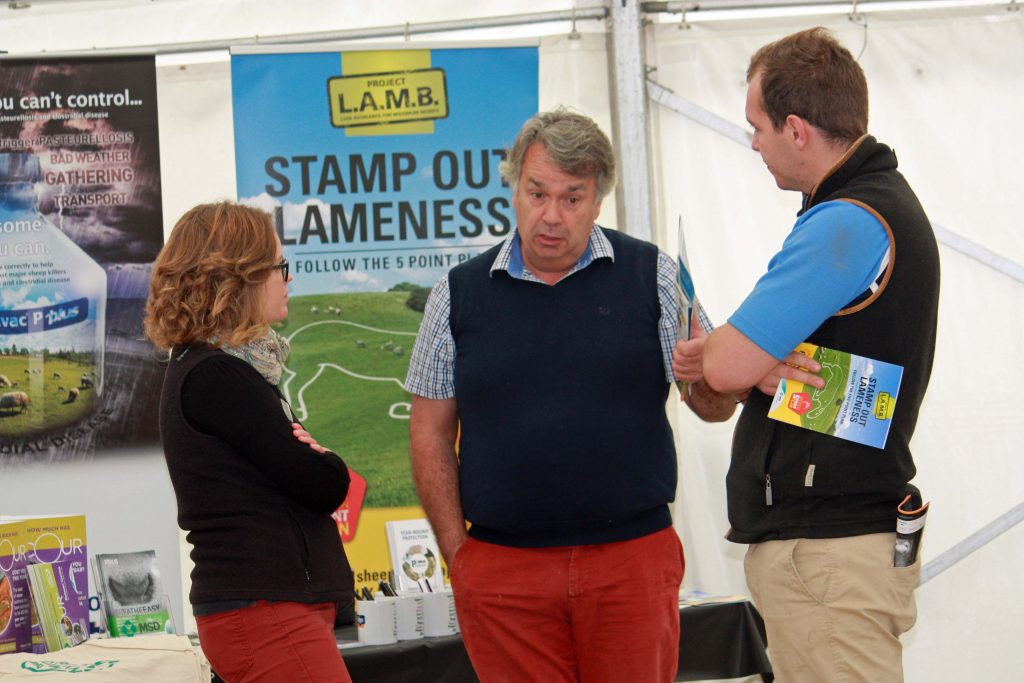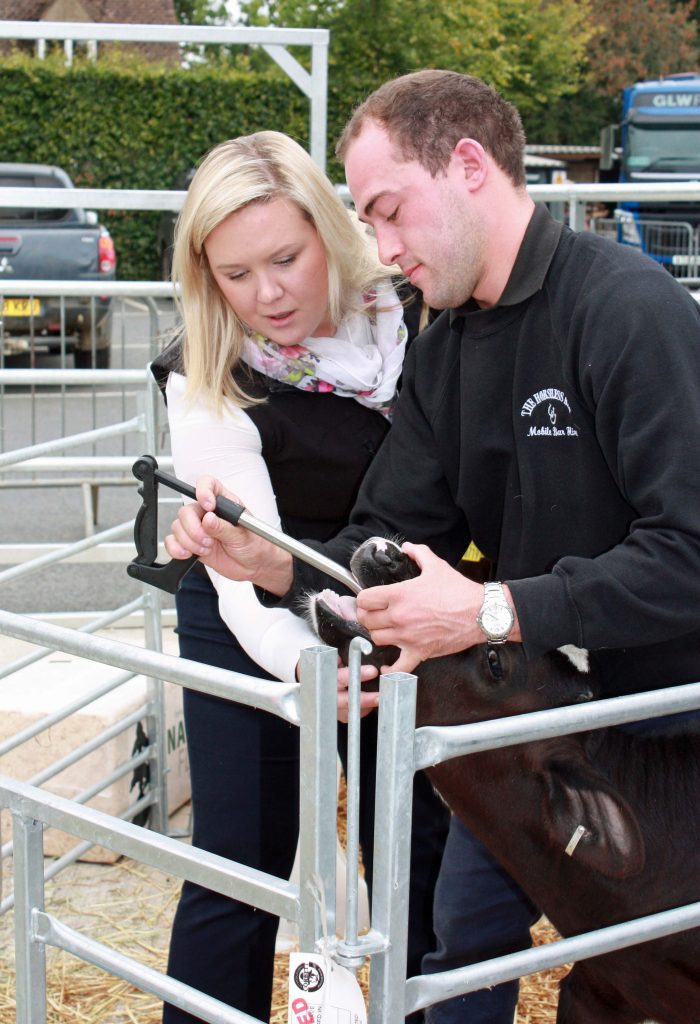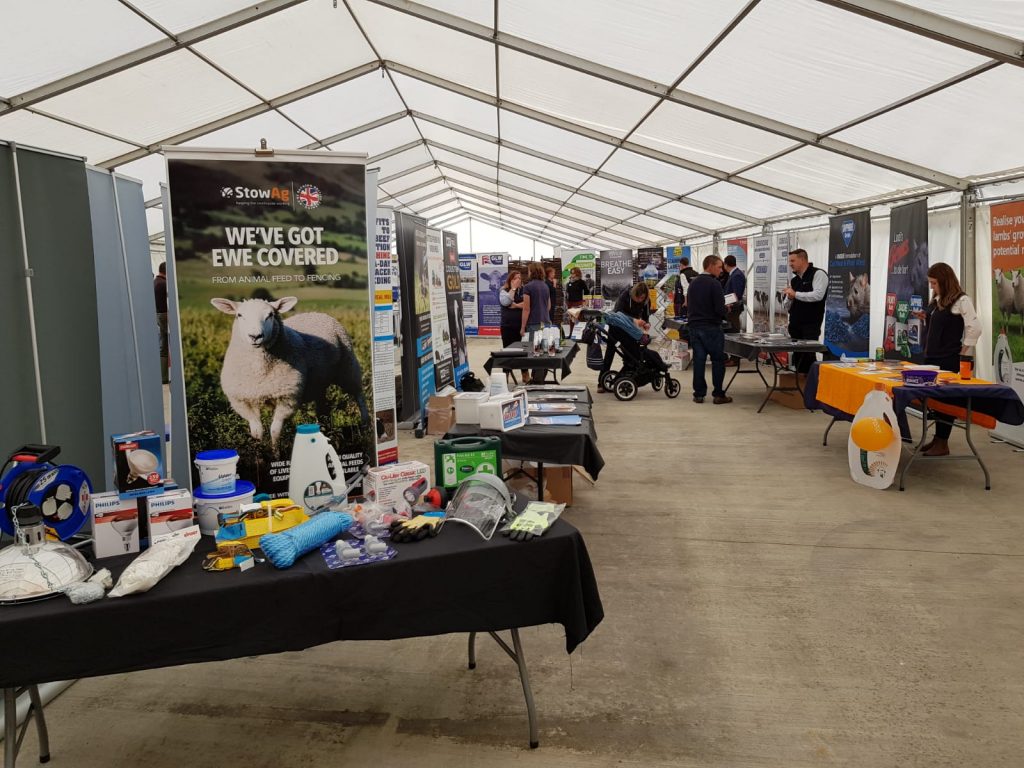Cattle winter housing event delivers expert advice
6th November 2018
Cotswolds-based agriculture supplier, StowAg, opened its doors in early October to 250 local farmers to host an information-packed Cattle Winter Housing Event. The event provided practical, expert advice from the
Cotswolds-based agriculture supplier, StowAg, opened its doors in early October to 250 local farmers to host an information-packed Cattle Winter Housing Event. The event provided practical, expert advice from the industry’s leading suppliers in addition to live demonstrations and an impressive product display.
Availability of trace minerals
Laura Drury MSc BSc, Rumenco Technical Advisor, highlighted the ‘disproportionate’ role that trace minerals play. Accounting for just 5% of the total ration these nutrients play vital roles within the body.
There are a number of recognised problems associated with deficiencies; low copper (or high molybdenum) is commonly associated with anoestrus, poor conception, embryonic death and delayed puberty. Low iodine can be responsible for still births, abortion and weak calves. Low zinc with lameness, mastitis and disease susceptibility. Low selenium with retained placenta, metritis, extended calvings, depressed immune function and poor conception rates.
An analysis of 320 grass silage samples from 2018 has shown high levels of potassium and low levels of copper, zinc, iodine and selenium. This year’s straw is very low in minerals. The results of this analysis obviously have important considerations for rationing and subsequent supplementation. These averaged silage results alone do not meet the optimum intake levels for cows particularly with reference to magnesium and trace minerals. Individual forage analysis is beneficial as results will vary across the UK.
Supplementation of copper for dry cows is recommended in the pre-calving period. Zinc, copper, iodine and selenium supplementation is recommended for the calves. There is an opportunity to ‘plug’ the forage gap by out-wintering cattle on fodder crops. These can provide up to 70% of an animal’s dry matter intake (DMI) providing an adequate fibre source is available.
Laura concluded by highlighting the role of the Rumenco MAXX Cattle Booster. Formulated to address deficiencies it is a high energy and protein, low moisture molassed feed and mineral bucket for growing cattle, dry and suckler cows, and is ideal for in-house cattle. Trace element supplementation is necessary year round to all livestock and copper should be available within multiple sources. Fodders crops should be supplemented with good phosphorus levels and trace minerals.
Fluke control
Matt Swanborough BVSc MRCVS, Southern GB Veterinary Advisor for Norbrook, detailed the complex life cycle of the liver fluke along with its detrimental effects within an individual and herds.
Liver fluke has a relatively long and complex life cycle lasting about 20 weeks. The adult fluke (around the same size as a £1 coin) sits in the bile duct feeding and producing a large number of eggs. These eggs pass out onto the ground. Miraciduim (free-swimming larvae) develop within that egg before they hatch and seek out their intermediate snail host. Within the mud snail host, the liver fluke goes through two further developmental phases including multiplication, before remerging 5 weeks later as large numbers of cercariae. Cercariae then form into little cyst like structures that wait on herbage ready to be eaten by your stock. Once ingested, immature fluke migrate to the liver where they tunnel their way through leaving considerable tissue damage on their way to becoming adults.
This whole life cycle is reliant on the mud snail host which thrives in warm (>10◦C), damp conditions. Whilst it was speculated that the liver fluke risk may have been reduced this year due to the prolonged dry conditions, be careful not to discount liver fluke quite yet. During hot weather, stock can often be seen congregating around sources of water which will often provide the perfect habitat for the mud snail.
Sheep and cattle infected with liver fluke will often present very differently. Sheep tend to show acute signs of anaemia and/or sudden death. This is caused by mass migration of immature fluke’s typically in late autumn and early winter. Subacute liver fluke in sheep can also result in anaemia, a loss in condition and bottle jaw. This is caused by both immature and adult fluke and typically apparent in late autumn and spring. Cattle do not seem to suffer from acute liver fluke but chronic cases present with mild anaemia, weight loss, bottle jaw and terminal diarrhoea. This is usually caused by a large build-up of adult fluke. Subclinical liver fluke in cattle must also be considered as it has been shown to reduce productivity and may predispose the animal to other diseases.
Where possible a liver fluke control plan should be double pronged in order to be effective. Environmental control in order to reduce the risk of infection, alongside strategic treatment with flukicides. Farmers are encouraged to develop a plan that is tailored to their farm.
Norbrook’s Closamectin, a combination of closantel (flukicide) and ivermectin (wormer) is available as both a soluble injection and a pour-on. Ideal for winter housing the pour-on helps to ensure maximum productivity throughout the housing period. Studies have shown closantel to be effective against fluke which are resistant to triclabendazole.
Feed nutrition
Paul Mardell, Ruminant Technical Manager for GLW Feeds, introduced the renowned family-owned company that produces high quality ruminant, poultry, pig and game feeds, delivered throughout the UK. Ruminant nutrition accounts for the larger proportion of the feeds they produce.
Paul provided an overview of the various systems at work in the UK; from intensive to extensive and the phases of rearing, growing and finishing within them. The cattle breeds within each vary according to their qualities.
During rearing, from birth to weaning, is a period of time known for the best feed conversion. Hand-reared calves drink 6 litres twice a day which needs to be provided at a consistent time, temperature and concentration. In comparison, the suckled calf has ad libitum milk with a low concentrate intake and therefore a more gradual; rumen development.
The growing phase is one of steadier growth, more associated within a semi-intensive system, and is a period of adding ‘frame and weight’. Animals within this phase have a large appetite relative to their live weight and require a high level of good quality forage nutrition. The amount of concentrate is matched to the quality of forage available and will depend upon forage analysis reports. DMI should be 2.5% of liveweight with a target daily weight gain of 0.7 to 1.2 kg.
The finishing phase is the final rapid growth phase which involves the lay down of meat and fat cover. Within this phase high levels of DMI should be maintained, aiming for an intake of 1.7 to 2% of liveweight and a target daily weight gain of greater than 1.3kg per day. The ration should include a crude protein of 12 to 14%.
Paul highlighted the important of good storage of all feedstuffs and providing palatable raw materials, reiterating that consistency is key. The rumen needs time to adapt to any changes within the diet.
Feed efficiency is a major cost in beef production. Good husbandry, including the daily observation of the animals, is valuable in recognising early problems within the herd. At any one time, 80% of the herd should be ruminating if they are not eating, drinking or sleeping. Monitoring faeces provides essential information relating to how the rumen is working; for example, loose dung can indicate acidosis and a potential lack of fibre and long particles or whole grains are a sign of “too much through put”.
Feed barrier design should allow easy access 24 hours a day with enough space for each animal. It is recommended that the eating surface should be smooth, cleaned out at least weekly, and fresh feed is always available. Cereals should not be ground into small particles and a source of long fibre should be available to encourage rumination along with clean fresh water in a well ventilated and comfortable bedded area.
Scour Prevention
Steph Small, Ruminant Veterinary Advisor for MSD, provided essential guidance on the multi-factorial problem of calf scour (diarrhoea – also known as enteritis) in the UK. The financial impact of scour is significant therefore mortality, treatment and labour costs, and especially decreased growth rates need to be taken into consideration. It is a widespread and largely underreported problem. At birth calves have no immunity of their own; the availability of good quality colostrum is paramount to the calf’s survival whilst their immune system matures.

Stephanie Small, MSD, talks to event attendees.
Steph described a case for decreasing the “infectious pressure” whilst increasing the “resistance of the calf”. Pathogens identified include viruses, bacteria and protozoa, and chances of a calf coming into contact with a higher pathogen load are increased in cramped and unclean environments. Factors which can increase the resistance of the calf include colostrum (the first intervention), nutrition (to maintain energy levels, keep warm, develop immunity and grow), stress and underlying disease.
Scour in calves causes irreparable damage to the villi (small finger-like projections) in the wall of the small intestine. The villi become stunted which decreases their surface area and consequently their ability to absorb nutrients. After scour, often villi cannot regrow which is why, for the rest of the animal’s life, growth can be stunted and productivity decreased. A five step control plan was proposed –
- Assessing the possible causes. This takes in to consideration the age of the calf (E. coli for example is most likely to affect calves between 1 and 5 days and usually proves fatal), colostrum management, feeding practices, housing and the presence of other diseases.
- Faecal sampling involves the collection of fresh samples from at least 5 animals. These can be tested on farm or sent off to laboratories but benefits and limitations of tests should be discussed with your animal health advisor.
- Evaluating colostrum intake. The calf should be drinking 10% of bodyweight 4 hours from birth, a 40kg calf will, therefore, require 4 litres of colostrum. This should be followed by a further 2 litres within 12 hours.
- Measuring colostrum quality with a colostrometer or BRIX refractometer is a simple and quick test to assess antibody level and can also be used to assess suitability of colostrum for storage for later use.
- On farm protocols to address scour prevention and treating affected animals. Vaccination of the cows with Rotavec Corona prior to calving can boost antibodies specific to rotavirus, coronavirus and E. coli within the colostrum.
Rotavec Corona increases the protection of individuals whilst helping to decrease the spread of pathogens through the herd. Intra muscular injection 12 to 3 weeks prior to calving has been shown to decrease the incidence and severity of scours, and also decrease the shedding of scour pathogens. In addition, calf serum antibody levels against all three pathogens were higher in calves receiving colostrum and milk from dams vaccinated with Rotavec Corona, when compared with calves fed colostrum/milk from unvaccinated cows. Colostrum is the most crucial factor for survival of calves very early in life, vaccination is convenient and when given correctly can aid in the control of one of the UK’s biggest threats to calf health: scour.
TB Prevention
Simon Smith from the TB Advisory Service provided practical guidance on reducing the risk of tuberculosis (TB). This free service, provided by DEFRA is available in both high and edge risk areas and provides bespoke guidance to farmers and landowners.
TB control currently has a four pronged approach which includes the removal of infected cattle, to reduce the trade of affected cattle, to reduce the interactions between wildlife and cattle and to remove the affected wildlife. Simon’s talk focused on reducing the trade of affected cattle and reducing the interactions between wildlife and cattle.
Every movement of cattle carries a risk but the risk can be reduced. When considering trades, private versus market sales should be considered in addition to the movement of younger animals compared to older and doing fewer, larger movements compared to multiple, smaller movements. Private gamma tests, ideally pre-movement, were recommended, in addition to initial isolation post movement. The iBTB website (www.ibtb.co.uk) maps bovine TB and can provide essential guidance.
Nose to nose transmission of TB rarely occurs (between cattle and badgers), therefore the more likely indirect transmission highlights the on farm risks (cattle coming into contact) within badger latrines/faeces, badger setts, urine, water troughs and feed/mineral licks. Consideration should include permanent or temporary fencing which may require regular maintenance and must not exclude a badger from a set which is illegal. Excluding badgers from latrines is also not advised as they will simply move it elsewhere.
Raising water and feed troughs and mineral licks to a minimum height of 1 metre and above will restrict access to the water source in addition to troughs with ‘rolled’ edges to prevent gripping. However, this is not useful on farms which include sheep. Emptying the troughs, regular cleaning and covering when not in use is strongly recommended.
Badgers will visit farmyards to feed, collect hay or bedding and simply when travelling from a to b. The concentrate store can provide a convenient pit stop to gorge on readily available food and therefore secure storage is highly advocated. Electric fencing around silage is also beneficial with four wires placed at 10, 15, 20 and 30 cm heights. Solid sheeted gates or gates with a gap of no more than 7.5cm are beneficial in addition to hard standing under doorways to prevent digging. Simon advocated the use of wildlife security cameras to assess the situation within your farm. Further details on the service TBAS provides can be found on their website at www.tbas.org.uk.
Bolus application
Kathryn Walker, Animax Territory Manager, provided essential guidance on trace element supplementation of the suckler cow. Kathryn examined the role of copper, cobalt iodine and selenium and their importance for health, production and fertility. Symptoms of deficiency were highlighted in association with each trace element.
Supplementation to ensure the optimum individual animal intake was highlighted to cover the most critical time when they are subject to the most challenge; from pre calving through to getting back in calf.

Kathryn Walker, Animax Territory Manager, oversees the application of a bolus to a calf.
Tracesure Cu/I is an intra-ruminal bolus with a unique leaching technology. Tracesure CU/I provides optimum levels of the four trace elements according to cow live weight to ensure requirements are met, bringing benefits to the cow and calf improving fertility, heath and production. Ultimately successful supplementation can help suckler cow producers to become more efficient and profitable.
Kathryn oversaw the practical administration of a bolus to a calf. The Animax Applicator provides a method for seamless administration of the bolus so that it is delivered safely and efficiently. The bolus provides optimum levels for six months following a single application.
A representative from Ritchie provided a live demonstration of their Continental Cattle Handling Crate. With a fully automated yoke and an auto reset facility, it is easily adjustable for different neck widths, allowing for easy handling of a variety of sizes of animals from calves to bulls. The cattle were moved seamlessly through the handler which allows access to both sides from both top and bottom. It is complete with a rear gate and aluminium tread-plate floor.
Also on display, and subject to much interest was the Calf Weighing Crate which is fitted with a Ritchie digital load cell. Incorporating a neck yoke for dehorning within a strong tubular steel frame and fully sheeted sides, this Calf Weighing Crate is easy to move, can be accessed from left and right sides and has a mesh floor.
The day was complete with a prize draw which included over £800 worth of prizes, refreshments and a hog roast. The generous prizes thrilled the winning attendees.
Charlotte Spafford, Group Marketing Executive, was “delighted to see so many customers, and potential new ones, and provide them with valuable practical advice to support them in their work. We would like to thank everyone who came and we look forward to seeing you again in the future.”

